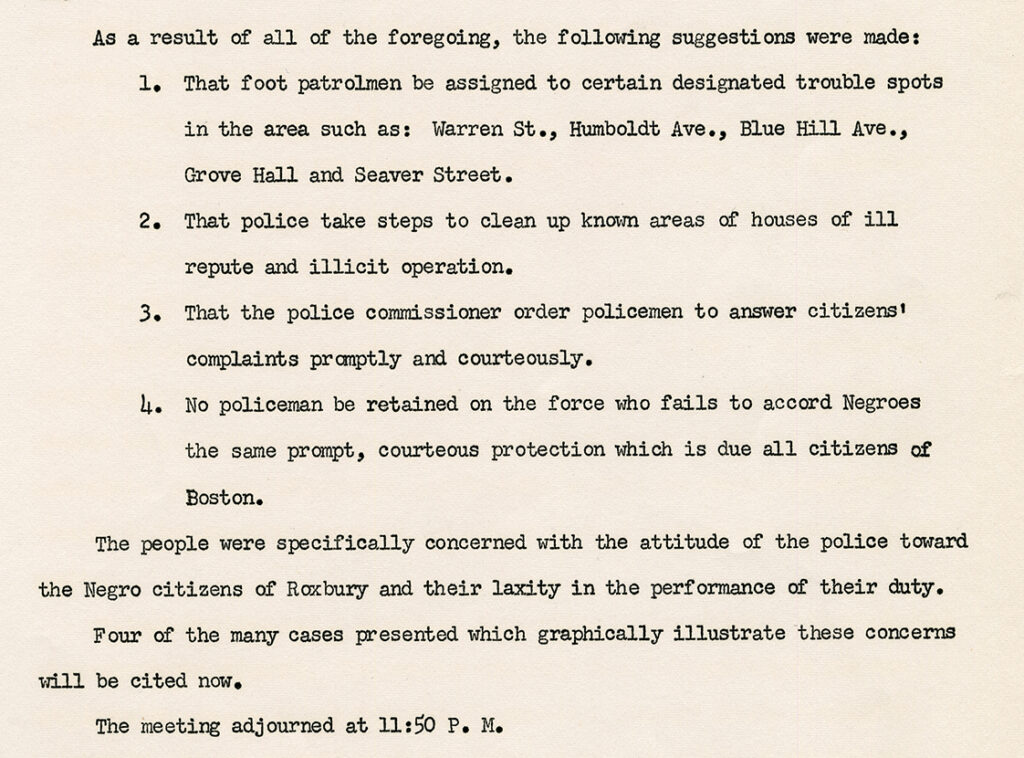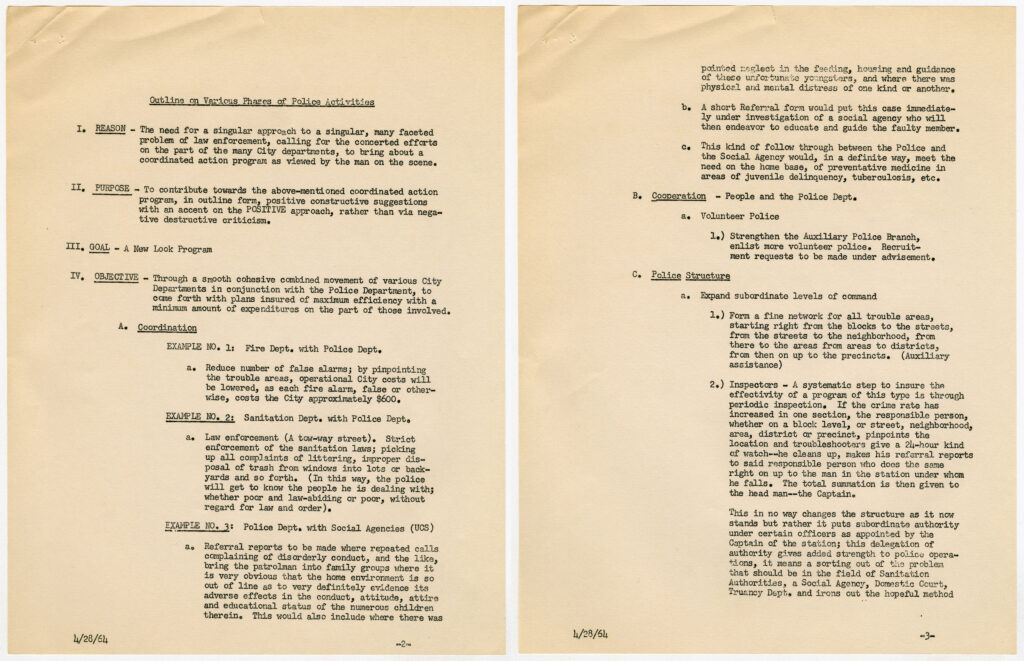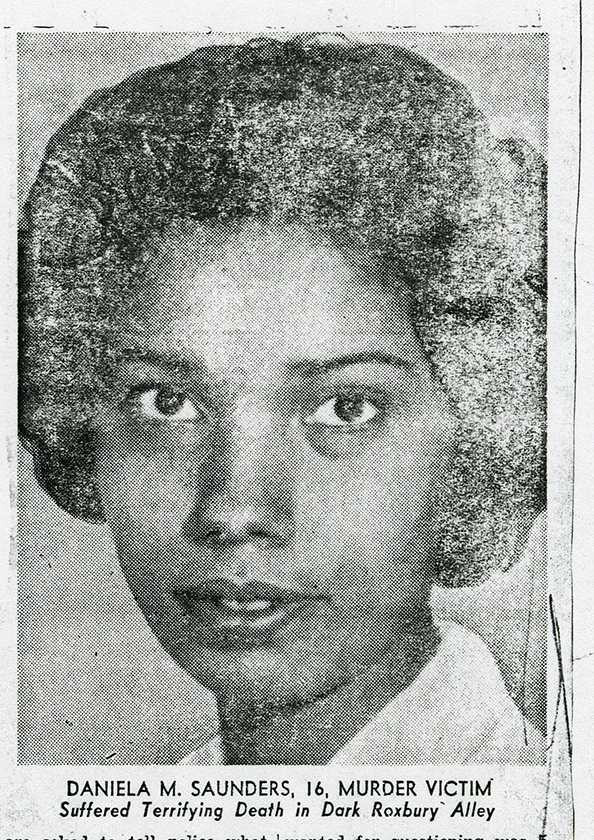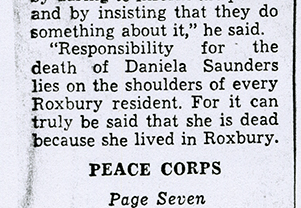The Freedom House digitization project has been an ongoing effort to make the archival records of the Freedom House Inc. Records available through the Digital Repository Service (DRS). Initially begun as a photograph-focused endeavor in 2007, the project has expanded to the print records of the collection with the aim to make broadly accessible the documentary evidence of Freedom House’s activities in community activism and urban renewal in Roxbury during the mid-to-late 20th century.
Introduction
Part of the digitization process includes the creation of metadata for each record so that people can find an individual item with the sea of documents. Metadata is the identifying information of a record, such as its title, author, creation date, and other components.
Recently, archivists have placed greater emphasis on the subject heading aspect of cataloging records.1 Archivists now recognize that the creation of subjects and descriptions as access points to a record is an inherently biased activity that can influence how one approaches and perceives the record itself and the topics it contains. While these access points are extremely helpful in improving search results, these pathways are created by archivists, i.e. people. Since archivists create metadata, the data reflects our perspectives, thereby making it imperative that we be mindfully aware of our unconscious biases. We must do the necessary self-evaluative work about ourselves, the power dynamics in which we function, and the multifarious impacts of our decisions on various groups.
Records are created within certain settings for certain purposes—whether political or social—and an archivist inserts the meta-narrative layer of collecting and making accessible those records. There is power in that process and traditionally the process has privileged dominant social systems, which then reinforces social inequities. The myth of neutrality in subject cataloging has led to subject headings that can reinforce biases, stereotypes, and offensive representations, as well as misrepresent and alienate marginalized communities. For instance, a reclassification project at GBH recognized the negative false equivalence of police only interacting with criminals in their legacy subject term “Law Enforcement & Crimes,” which they have changed to “Legal System.”2
Recently, many archivists have risen to the challenge of acknowledging the persistency of power dynamics and are actively seeking to infuse their metadata creation with inclusion, diversity, and social justice practices. I myself have recently undertaken the ethical reasoning behind the use of certain subject headings to achieve descriptions that not only increase searchability and accuracy but also are respectful and empowering to subjects previously ignored. It is my hope that by developing cultural competency, the records will be more accessible to the communities reflected in their content, which may be one small step towards actively dismantling oppressive systems.
The Collection and Daniela Saunders
As I digitized the Freedom House Inc. Records, I stumbled upon an eye-opening folder about the Police-Community Relations Committee. The records from this folder of items from 1960 to 1966 document a growing awareness in Roxbury of police-community relation issues. At the time, there were community memories of problems and instances a decade prior. Back in 1952, the murder of Rabbi Zuber sparked meetings calling for community action. However, the initial uproar dwindled and while close relations and neighbors continued to fight for change, it was a small endeavor.

Some larger efforts did persist, including a Police-Community Relations Institute Conference held in 1960 that connected with religious organizations to discuss the relations between mass media, social work agencies, the judicial court system, civil rights, legislation, and the police. However, the improvements called for in the decade of discussions did not become sweeping real-world improvements. As a result, over the course of a year between the summers of 1962 and 1963, there were a number of stranglings of women in the greater Boston area.3
On January 5, 1963, 16-year-old Daniela Saunders was murdered in an alleyway between Warren Street and Elm Hill Park, just a few blocks from her home. The next day, 500 members of her community met with Otto P. Snowden and Freedom House to discuss what underlying social problems led to the tragedy. Initiated by a small group of mothers voicing the need to prevent such violence, the meeting expanded to the 500-person turnout. Many individuals voiced their perspectives on the issue:
- Dewey Duckett outlined the general disinterest of the Boston Police Department Division 9 towards the community it was supposed to protect. He talked about how “the local police had clearly evidenced an incapacity to understand or respect either the local citizens themselves or their simple desire for minimal adequate protection.”4
- Attorney Benjamin Johnson called for the creation of a 100-person auxiliary police of community members.
- Mrs. Leona Tynes cited the practical issue of poor lighting facilities.
- Mrs. Oswald Jordan recalled the aftermath of Rabbi Zuber’s murder and described the emotional toll of these types of meetings over the last decade since they had not led to any actual change.
At the end of the meeting, the goal was set to create a committee to meet with city officials, namely Commissioner Edmund L. McNamara, Captain Paul Sullivan, and Sergeant Kelly of Division 9. The other four main suggestions were to add foot patrolmen; ensure that police answered complaints with courtesy instead of their current lack of sensitivity; increase the effort to improve problem areas; and fire police that demonstrated bias towards the black community.

Another meeting held January 8, 1962, at the Jeremiah E. Burke School further expanded the four main issues. About 1,500 citizens gathered to demand change. Kenneth Guscott, representing the NAACP, called for a Villante Committee similar to what the Peace Corps created in Harlem. Police Commissioner McNamara personally attended this meeting, although he was met with objections when he attempted to downplay his former neglect by referring to his personal connection with a black member of the police force.
The various efforts aimed to “promote a better understanding between the protected and the protector.”5 The end goal was a positive coordinated action program formulated and carried out by neighborhood associations in affiliation with the local police. Along with Mayor John F. Collins and Commissioner McNamara’s immediate pledges to increase training in criminal investigation and compulsory attendance of courses at Northwest University and the FBI National Academy, the events led to long-term communication between the Roxbury community, city officials, and the police. The Freedom House Inc. Records reflect and display these sustained efforts.


Daniela Saunders’ Impact
The events of Daniela Saunders’ murder and the aftermath from Roxbury’s community response are integral components to the larger historic narrative of the police-community relations documented in the Freedom House Inc. Records. Her story may be limited to a folder in this vast collection but her impact disseminates through many boxes. So many activities were initiated by her tragic demise.
However, most metadata elements do not provide space for Daniela. She wasn’t the author or creator of the records, she was not included in the title of the records, and her name was often eliminated in the documents themselves. Within the records of Folder 1015, Daniela was more of a ghost, a whisper, trickled throughout the newspaper articles, letters, meeting minutes, and reports. She may have been the impetus for change, but she didn’t have agency in these metadata components.
Additionally, in the larger historic narrative, Daniela has been forgotten. She is currently not listed as one of the Boston Strangler’s 13 victims despite the connection to the “Phantom Strangler” made in 1963.6

When making the metadata for items in Folder 1015, I wanted to allow Daniela to regain her own agency in being remembered. The power of remembering is enormous—it becomes public memory and informs current events. Therefore, archival records provide an opportunity to bear witness to an event when it has been lost to time. I knew I needed a way to provide a pathway to Daniela and link her to these records. I produced these conditions by making Daniela a Name Subject Heading, a practice that we are not often implementing in the Freedom House Inc. digitization project. Due to the large scope of the collection and the logistical issues of maintaining authorized subject headings over 83 containers, Name Subject Headings for individuals are a rare occurrence.
However, with the addition of this metadata component, Daniela’s story becomes accessible to the public. She is no longer a passive victim, marginalized and obscured, but is now an active agent at the forefront of police-community relations in 1963 Roxbury. People can now find the records related to Daniela and they can situate her contribution within the larger Freedom House and Roxbury narratives.
Additionally, the records can give the public a resource for holding historical agents accountable. The 1960s were fraught with many issues between communities of color and the police nationwide. The events of 1963 in Roxbury become a part of that larger context.

Finally, by recognizing Daniela and the events of 1963, I hope that the records and their metadata have an enduring impact on our current society. Police brutality, racism, abuse, systematic oppression, and unnecessary force are all topics that we see in the news every day. Past calls for better training and systematic changes to the police force are similar to present-day news stories. We are constantly exposed to the reality of this violence and our nation collectively feels an emotional toll possibly similar to the one described by Mrs. Oswald Jordan in January 1963. Maybe these historic records can help inform our present discourse. By knowing what happened in the past, maybe we can make more informed decisions, and ultimately, be the change we strive to see.
For more information about police-community relations in the 1960s, you can visit the folders on Police-Community Relations Committee, 1960-1966; Police-Community relations, 1960-1966; and Police-Community Relations Conference of the National Consortium for Continuous Improvement in Higher Education (NCCI), 1966. These folders 1015-1017 are newly available on the DRS website here.
1A non-comprehensive list of recent literature includes, Jillian Ewalt, “Toward Inclusive Description: Reparations through Community-Driven Metadata,” NEA Newsletter 46, no. 2 (April 2019): 4-7; Rosale de Mattos, “The Representation of Archival Information in Controlled Vocabularies: The Context of the Archival Institutions in Rio de Janeiro,” Knowledge Organization 47, no. 7 (2019): 548-557; Samuel J. Edge, “A Subject “Queer”-y: A Literature Review on Subject Access to LGBTIQ Materials,” Serials Librarian 75, no. 1-4 (Jul-Dec 2018): 81-90; Gracen Brilmyer, “Archival assemblages: applying disability studies’ political/relational model to archival description,” Archival Science 18, no. 2 (Jun 2018): 95-118.
2Miranda Villesvik and Raananah Sarid-Segal, “Making Metadata Inclusive to Marginalized Voices” (presentation, Archives for a Changing World, NEA Spring Conference, Virtual, March 27, 2021).
3The Boston Strangler continued to murder young women in the Boston area until 1964. For more information, see Ronald Lettieri, “Boston Strangler.” Salem Press Encyclopedia (2019); Jess Bidgood, “50 Years Later, a Break in a Boston Strangler Case,” New York Times, July 11, 2013; Paul Hoblin, Boston Strangler (Unsolved Mysteries). Abdo Publishing, 2012; Susan Kelly, The Boston Stranglers: The Public Conviction of Albert DeSalvo and the True Story of Eleven Shocking Murders. Secaucus, N.J.: Carol Pub. Group, 1995.
4“Report from special community meeting about police issues, Daniela Saunders and Rabbi Zuber murders, and race relations held January 6, 1096.” January 6, 1963. Freedom House Inc. Records (M16). Northeastern University Library. Archives and Special Collections Department. Northeastern University, Boston, Massachusetts. Box 30, Folder 1015.
5“Outline on various phases of police activities.” April 28, 1964. UASC identifier: M16_B030_F1015_005. Freedom House Inc. Series 3: Programs. Sub-Series B: Urban Renewal. Neighborhood Associations. Police-Community Relations Committee, 1960-1966.
6Jack Thomas, “Victims of the Boston Strangler,” The Boston Globe, July 11, 2013. https://www.bostonglobe.com/metro/2013/07/11/victims-boston-strangler/CwbsZlSNcfwmhSetpqNlhL/story.html